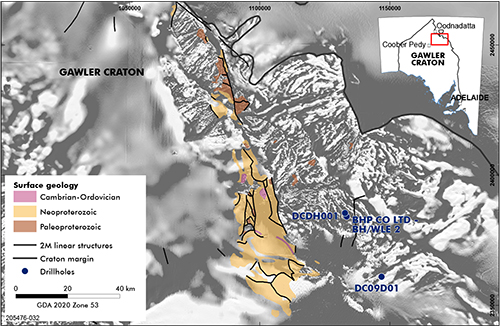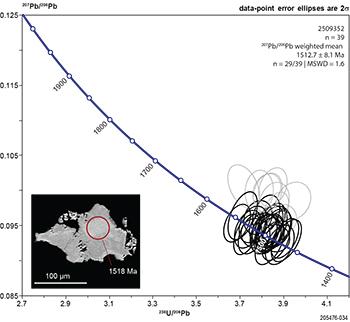The young (and Cloncurry-like?) evolution of the northeastern Gawler Craton.
The mineral wealth of the c. 1590 Ma Hiltaba Suite – Gawler Range Volcanics event in the Gawler Craton is well established and globally recognised. This timeline is often thought to be the last regionally significant event in the Gawler Craton. However, new research is highlighting that significant alteration, metamorphism and deformation occurred between 1550–1450 Ma in the northeastern Gawler Craton, strengthening its links to mineralising events in the copper–gold rich Cloncurry region, Mount Isa Inlier, Queensland.
The Source to Spectrum (S2S) Australian Research Council Linkage project is focused on understanding how the spectrum of base and precious metal deposits in the Gawler Craton formed during the early Mesoproterozoic, and the likelihood of their preservation throughout the later events. This includes work in collaboration with Minotaur Exploration in the Peake and Denison Inliers in the northeastern Gawler Craton that has been undertaken as part of a PhD project by the lead author, Mitchell Bockmann.
The Peake and Denison Inliers are an intriguing greenfield area for exploration (Fig 1). Previous workers outlined geological similarities to the Mount Isa Inlier, with the timing of late Paleoproterozoic magmatism and sedimentation being similar to the Eastern Fold Belt (e.g. Hopper 2001). Until now, the timing of late-stage magmatism and fluid flow in the Peake and Denison region has been poorly constrained, limiting any correlations between alteration systems.
Figure 1 Gawler Craton Airborne Survey total magnetic intensity reduced-to-pole first-vertical derivative image highlighting the extent of the Peake and Denison Inliers, overlain by areas of exposed Proterozoic and Cambrian–Ordovician rocks, and sampled drillholes.
New timings and new model
New zircon and titanite U–Pb geochronology of igneous rocks has redefined the timing of magmatism and alteration in the Peake and Denison Inliers. Analyses were undertaken using laser-ablation ICP-MS (inductively coupled plasma - mass spectrometry) methods at Adelaide Microscopy.
Emplacement of a foliated granitoid intersected in drillhole DCDH001 (SA Geodata drillhole 188530) has been constrained to 1739 ± 6 Ma with the foliation developed at 1497 ± 12 Ma. The 2 ages are constrained from zircon cores and rims, respectively. An unfoliated granitoid from the same drillhole records a zircon crystallisation age of 1470 ± 10 Ma.
An episodic alteration history is recorded in the studied samples. A titanite age of 1468 ± 8 Ma from the foliated granitoid is interpreted to record the timing of minor chlorite alteration. Titanite associated with epidote–chlorite alteration within a felsic rock in drillhole BHP CO LTD - BH/WLE 2 (16836) was dated at 1482 ± 11 Ma. A pegmatite sample in drillhole DC09D01 (247881) that contains titanite associated with actinolite alteration was dated at 1566 ± 12 Ma. Titanite within a calc-silicate gneiss (DC09D01) that contains a hematite–calcite vein was dated at 1513 ± 12 Ma (Fig 2). Collectively, this work is important as it is directly dating alteration events as opposed to simply dating an undetermined cooling or resetting event.
Figure 2 Titanite U–Pb isotopic data from altered calc-silicate gneiss in drillhole DC09D01 presented on a Terra-Wasserburg concordia plot, with a representative analysis shown on a titanite backscattered electron image. Discordant analyses shown by grey ellipses are not included in age calculations.
The ages, combined with observations from the 2 granitoids, tell a concise but important story about the relationships between magmatism, deformation and alteration in the Peake and Denison Inliers. The foliation constrained from zircon rims at c. 1500 Ma was not recorded in the post-tectonic granitoid at c. 1470 Ma, indicating that active tectonism had ceased by this time.
The similarity in the timing of post-tectonic granitoid emplacement and the age of alteration in the older foliated granitoid suggest the second pulse of magmatism was a possible source of fluid for the alteration. The corresponding alteration age acquired from BH-WLE 2 largely supports young magmatism being the source of fluids in this area. However, the range of alteration ages from DC09D01 suggests the Peake and Denison Inliers have seen a more prolonged history of high temperature fluid activity, possibly starting as early as c. 1570 Ma.
These timelines show a remarkable correlation with the Eastern Fold Belt or Cloncurry regions of the Mount Isa Inlier, and these similarities influence the exploration model currently employed by Minotaur Exploration. Further testing of the correlations and mineral potential is the focus of the Accelerated Discovery Initiative (ADI) Round one project co-funded by Minotaur Exploration and the Department for Energy and Mining.
Both the S2S and ADI projects highlight the value that can be gained towards innovative exploration models by collaborative investigations between the industry, government and university sectors.
Reference
Hopper DJ 2001. Crustal evolution of Palaeo- to Mesoproterozoic rocks in the Peake and Denison Ranges, South Australia. PhD thesis, University of Queensland.
– Mitchell Bockmann1, Justin Payne2, Laura Morrissey2, Martin Hand1, Anthony Reid3 and Tony Belperio4, June 2021
1 University of Adelaide, 2 University of South Australia, 3 Geological Survey of South Australia, 4 Minotaur Exploration




